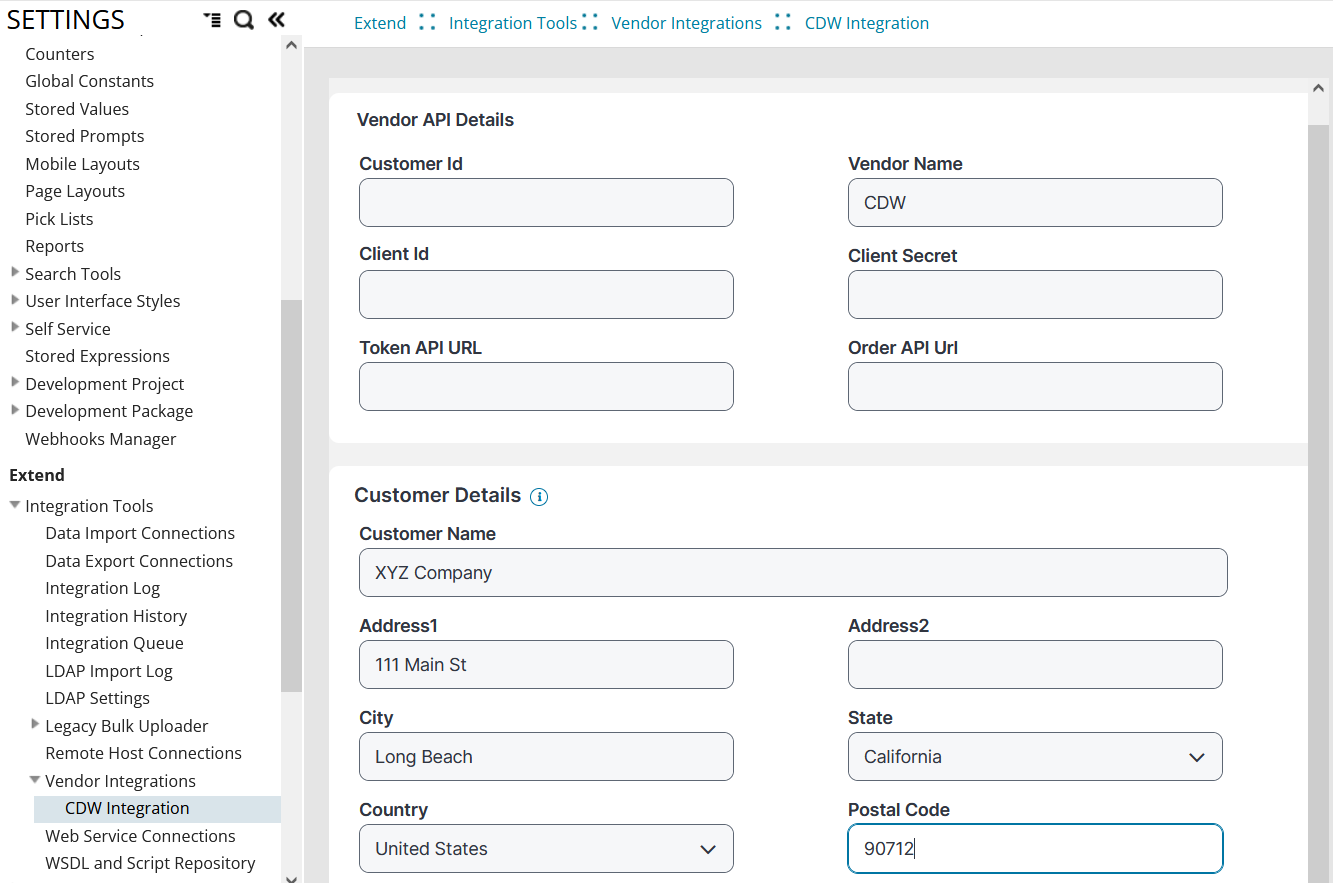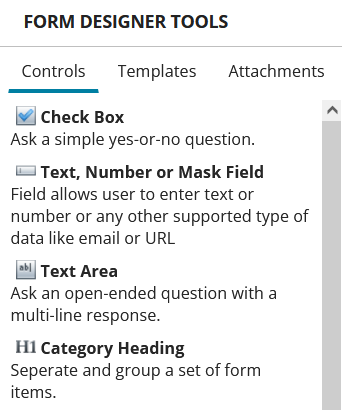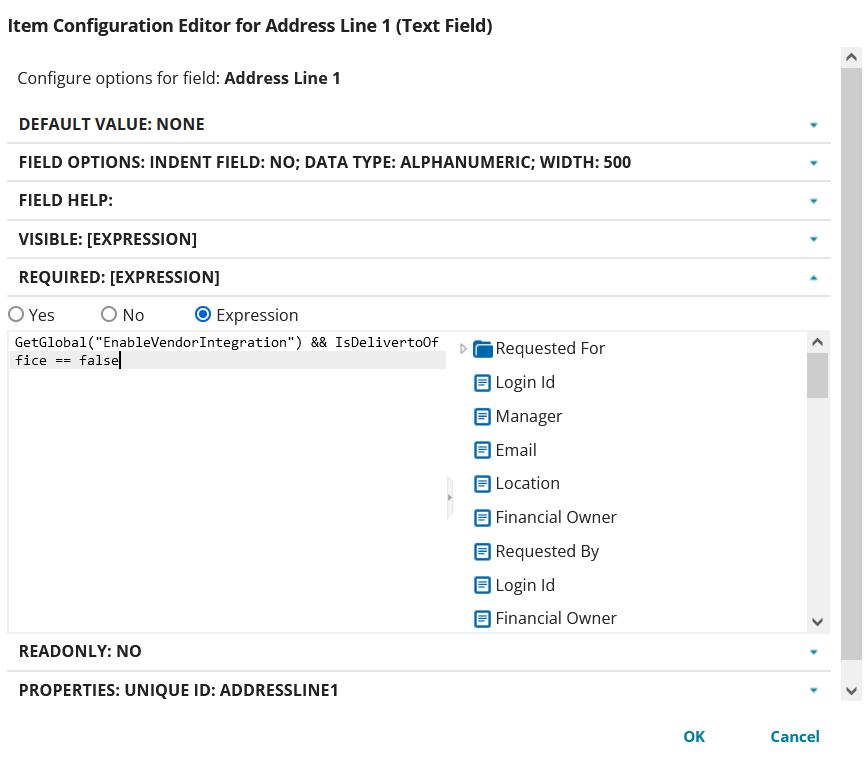Integrating with CDW
Starting with ITAM v2023.3, you can streamline the process of hardware asset procurement by integrating with the value-added reseller CDW. This means that if an asset request from ITAM's online Product Catalog requires a CDW purchase order, you can raise that order directly to CDW with several clicks from the ITAM user console.
With ITAM v2023.4, there are two new CDW integration features:
•CDW shipment and invoice data now display in the console and dynamically update with the purchase order's status.
•The ITAM Product Catalog's Asset Request form includes a Deliver to Office check box, which employees can select to automatically use the default delivery address configured for CDW integration. This means they no longer have to fill in the address fields manually.
Product requirements
Both Ivanti Neurons for ITAM and ITSM v2023.3 must be operational in your work environment for CDW integration to work. To raise CDW purchase orders that also include shipment and invoice data, ITAM and ITSM v2023.4 or above are required.
This topic assumes you have the correct version of ITAM and ITSM installed for the type of integration you want. To download the minimum version of the consolidated package required for CDW integration, see this page of the Ivanti Marketplace.
Getting started
You first need to register ITAM as an application on the CDW website. Contact your CDW representative for guidance. During registration, make note of the customer and client IDs, client secret, token API URL, and order API URL—you’ll need these for the procedure below to configure CDW integration within ITAM.
It’s recommended that you test the app registration and API in a pre-production environment before going live. For a pre-production environment, the source server IP needs to be whitelisted with CDW so that they can control the requests coming in; otherwise, the CDW API will produce a 403 unauthorized error. This step is not necessary in a production environment.
Next, access the ITAM user console to configure it for CDW integration.
To raise CDW purchase orders from the console without shipment and invoice data you need to:
• Turn on the EnableVendorIntegration global constant for vendor integration.
•Configure CDW integration, which includes address fields so that CDW knows where to ship your company’s purchase orders.
•Add address fields to the ITAM Product Catalog's Asset Request form that match the ones you entered for CDW integration above. This procedure is required for upgrade customers only. For new customers of ITAM v2023.3 and above, these fields exist by default.
•Add CDW hardware items to the ITAM Product Catalog. Items must be of asset type Computer and/or Consumable.
To raise CDW purchase orders that include shipment and invoice data, you also need to:
•Enable the Webhook for PO invoice and shipment data from a third party.
1.Log in as Asset Administrator.
2.Click the ![]() icon at the top of any workspace. The Configuration Console displays in a new browser tab.
icon at the top of any workspace. The Configuration Console displays in a new browser tab.
3.In the left navigation pane, expand to Build > Global Constants.
4.Find EnableVendorIntegration in the list and set it to True.
5.Click Save.
To turn off integration with CDW at any point, set this same global constant back to False. This will hide the address fields on the Asset Request form that are necessary for integration.
1.Log in as Asset Administrator.
2.Click the ![]() icon at the top of any workspace. The Configuration Console displays in a new browser tab.
icon at the top of any workspace. The Configuration Console displays in a new browser tab.
3.In the left navigation pane, expand Extend > Integration Tools > Vendor Integrations > CDW Integration. This option only displays if the EnableVendorIntegration global constant has been set to True.
4.Fill in the fields—all are necessary. The vendor API details enable ITAM to connect to the CDW website. The customer details ensure CDW knows where to ship your company’s purchase orders.
•Customer ID: The unique identifier associated with your CDW account.
•Vendor Name: CDW is the vendor in this case.
•Client ID: The ID used to authenticate your CDW account, generated during the registration process.
•Client Secret: The secret associated with your client ID, generated during the registration process.
•Token API URL: The API token associated with your CDW account and provided by CDW.
•Order API URL: An order API associated with your CDW account and provided by CDW.
•Customer Name: Your company’s name.
•Address/City/State/Country/Postal Code: The default company location you want CDW to ship all purchase orders to.
5.Click Submit. If the configuration was successful, you’ll see a pop-up indicating success.
This procedure is required for upgrade customers only. For new customers of ITAM v2023.3 and above, these fields exist by default.
Address fields are necessary for CDW integration to work. As part of an asset request, employees will be required to fill in these fields to indicate where the items should be delivered. The address they enter will need to match the address entered as part of the CDW integration procedure above.
The ITAM user roles of Asset Administrator, Asset Manager, and Procurement Manager can complete this procedure.
For details not provided here about editing request forms, see the ITSM help topics under About Request Offerings.
1.Open the Request Offerings workspace.
2.Click General Services in the left pane, then click Computer Request from Product Catalog in the list. To edit the form for consumables, click Consumable Request from Product Catalog and follow the same instructions below.
3.Click Design request form at the top of the page. Add the following fields and options to the form, starting with step 4 below. Enter the expressions and property IDs exactly as shown:
•Field: Deliver to Office (for v2023.3 this field is hidden from the form, but it's used for internal validation and will be visible in future releases); Control: Check Box; Visible: No; Properties Unique ID: IsDelivertoOffice
•Field: Address Line 1; Control: Text, Number or Mask Field; Visible: Expression GetGlobal("EnableVendorIntegration"); Required: Expression GetGlobal("EnableVendorIntegration") && IsDelivertoOffice == false; Properties Unique ID: AddressLine1
•Field: Street; Control: Text, Number or Mask Field; Properties Unique ID: AddressLine2
•Field: City; Control: Text, Number or Mask Field; Properties Unique ID: AddressCity
•Field: Postal Code; Control: Text, Number or Mask Field; Properties Unique ID: AddressPostalCode
The State and Country fields require drop-down pick lists that will enable employees to select from available options stored in the ITAM database.
•Field: State (if this field existed previously on the form as a text field, delete it and create from new as a drop-down field); Control: Drop-down selection; Pick List: Validation list; Validation list to use: State Address US and Canada State (the Title Field will default to State Long—leave as-is); Properties Unique ID: State
•Field: Country; Control: Drop-down selection; Pick List: Validation list; Validation list to use: Countries Full Name (the Title Field will default to Country Full Name—leave as-is); Properties Unique ID: AddressCountry
4.In the Form Designer Tools pane, double-click the control type you want to use for the new field. 
The control type you selected will display as a text box next to the control itself, similar to this:
5.Place your cursor in this text box and type the name of the field. A description is optional.
6.Click the ![]() icon to the left of the new field name to open the Item Configuration Editor dialog. Edit the options to match the ones listed above for each new field, then click OK. Leave as-is any options not listed above.
icon to the left of the new field name to open the Item Configuration Editor dialog. Edit the options to match the ones listed above for each new field, then click OK. Leave as-is any options not listed above.
7.Repeat steps 4-6 for each field you're adding.
8.If needed, you can reorder any of the fields in the Request Form list by dragging and dropping them to a new position.
9.Preview the updates, then click Save & Exit.
The new fields will display in the Preview page and online Product Catalog only if you've set the EnableVendorIntegration global constant to True.
The ITAM user roles of Asset Administrator and Asset Manager can complete this procedure.
1.Open the Product Catalog workspace.
2.Add hardware items (of asset type Computer or Consumable) that you want to make available for purchase from CDW. For details about adding hardware items to the Product Catalog, see Product Catalog.
Beyond the usual required fields, the Part Number field is also mandatory for each added item. Fill it in with the CDW-supplied part number. If the part number is missing, you will not be able to raise the purchase order to CDW via the ITAM user console.
3.Save each item, then click Submit for Approval (at the top of the page), so that the status changes to Approved.
1.Log in as Asset Administrator.
2.Click the ![]() icon at the top of any workspace. The Configuration Console displays in a new browser tab.
icon at the top of any workspace. The Configuration Console displays in a new browser tab.
3.In the left navigation pane, expand Build > Webhooks Manager.
4.Find Ivnt_PurchaseOrder Invoice and Shipment in the list and toggle its status to Enabled. The enabled status automatically saves.
Procuring assets from CDW using the ITAM user console
Once the procedures above are completed, you should be able to raise a CDW purchase order directly from the ITAM user console when needed. You can do so after an employee has submitted a CDW asset request that meets the following conditions:
•The request requires a purchase order.
•The request is for a standard CDW item listed in the ITAM Product Catalog. Non-standard items are not allowed.
•The address added in the request form matches the same address entered for CDW integration above. Someone other than the submitter, such as a Procurement Manager or Service Desk Analyst, must verify that the fields match before the purchase order can be raised to CDW.
For v2023.4 users: If the employee selected the request form's Deliver to Office check box, the addresses will automatically match.
For details about submitting an asset request, see Asset requests.
The ITAM user roles that can manage this workflow are Asset Administrator, Asset Manager, Procurement Manager, and Storage Manager.
1.Open the Asset Requests workspace, then open the submitted request.
2.Review the request details to ensure the address fields for city, state, and country match the same fields entered during CDW integration configuration above. Edit the fields if necessary.
3.Click Create Purchase Order (at the top of the page). This action does three things in the Purchase Orders workspace:
•It creates the CDW purchase order and associated line item within ITAM.
•It generates a purchase request number as the PO name.
•It sets the purchase order status to Created.
4.Open the Purchase Orders workspace, then open the newly created CDW purchase order.
5.Click Submit (at the top of the page) to change the status to Approved.
6.Click Raise PO Vendor to initiate the order within the CDW system and generate an asset request number. If successful, the status will change to On Order and the Vendor Order Status tab will update with the purchase order.
7.Click Save.
If the ability to view shipment and invoice data is enabled, those details will display under the purchase order's Shipment and Invoice tabs and will dynamically update with the order's status. You can click those tabs to view more details in the Shipment and Invoice workspaces respectively.
From the Vendor Order Status workspace, you can track the progress of all CDW purchase orders. If an error occurs upon raising the purchase order to CDW, this workspace provides an error description that can help you troubleshoot the issue. Open the purchase order to view details about the error.